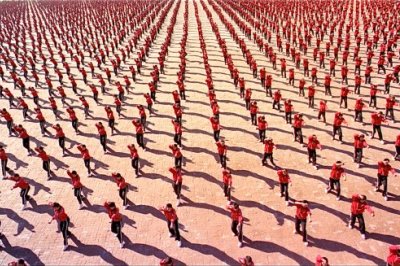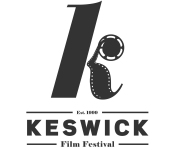Reviews - Samsara
Samsara
Reviewed By John Stakes

Samsara
Last Sunday the club’s travels took members some distance along the A66 but nowhere as far as the specially engineered for Imax camera was taken by its owner in the making of one of the most awe inspiring and challenging films of recent years.
US director Ron Fricke’s passion for over 20 years has been to film in large format style and particularly for the giant Imax screen. Having directed such Imax formatted films as "Chronos" in 1985 and "Sacred Site" in 1986 (7 minutes of Halley’s Comet over Ayers Rock), he pioneered the development of the first Imax compatible camera which led to the first screening in Imax cinemas of his "Baraka" in 1992.
"Baraka" ("the Blessing") was filmed in 20 countries and was described by its maker as a kaleidoscopic global compilation of natural events and fate, and took five years to complete. Twenty years on his passion for the beauty, contradictions, and mystery of our world remains undimmed. For his sequel "Samsara" screened last Sunday at Reghed Fricke used "Baraka" as his template to visit no less than 25 countries this time and to delve more critically into life on our planet than he had done in his earlier work. In Hinduism and Buddhism "Samsara" refers to the cycle of birth, death and rebirth through karma, and Fricke’s film amounts to a visual exploration of this cycle.
There is no attempt to explain or comment on any of the visually stunning images garnered from around our world. There is no voice-over. The images are accompanied by a music score from Michael Stearns who had scored for "Chronos", "Sacred Site" and "Baraka", and had once even backed Lovin’ Spoonful! There were also contributions from Marcello de Francisci and Lisa Gerrard in what this reviewer has learned is "7.1 sound surround design". In simple terms this means that the soundtrack reverberates around the auditorium. The result is "pure cinema". We were assailed, confronted by, and manipulated in glorious 70mm as Fricke felt digital photography fell short of the definition he required to give his images maximum impact.
As with "Baraka" Fricke indulges his love of time-lapse photography ("to capture the lifeblood and pulse of our planet") and long tracking shots. The film brilliantly fuses natural and technical phenomena so there are times when we might question whether some of the scenic shots are CGI creations or enhanced real life images. Fricke assures his followers that no artificiality was involved in the cinematography, even in his wondrous depiction of Burmese castles. Once again it took him five years to complete this work. On occasions he has said, he had to wait months until he felt "the light was right", such was his attention to detail.
Fricke initially lured us into a false sense of cosy contentment by focusing on some beautifully adorned faces and breathtaking vistas. It was as if he had collaborated with French aerial photographer Yann Arthus-Bertrand (The Earth From The Air) to produce some stunning overhead shots of deserts and islands accompanied by cosmic mood music.
But the picture changed dramatically when he moved into the arenas of mass production and consumption, and the exploitation of our planet. Gargantuan scale factory farming, and the juxtaposition of the conditions of the rich and poor, made for profoundly uncomfortable and ultimately dispiriting viewing. The politics and entrails of greed and voracious consumption were gut-wrenchingly displayed. This was not a film for omnivorous parents of multitudinous children to savour. The absence of any voice-over explanation did not detract from the visual manipulation at work. If the object was to stop us short in our mountain tracks of detritus and think about the direction of the human condition, the film succeeded brilliantly: compulsive but at times repellent. The film cried out for but will never receive a world wide screening.
"Samsara" premiered at the 2011 Toronto International Film Festival but was not put on general release until August 2012. For the man who was the second unit director of the 2005 "Star Wars III the Revenge of the Sith", filming the real world has proved far more illuminating than bringing the world of science fiction to our screens, but the imagery was so hauntingly unusual that, at times, it was difficult to separate the two. Clearly Imax and Fricke were made for each other and how fortunate for us that we did not have to go halfway round the world to see his work displayed to such numbingly unsettling but morbidly beautiful effect.
Keswick turned out in substantial numbers for the screening of Fricke’s roving masterpiece and voted it amongst the best of a hugely thought-provoking season. Next Sunday features another extraordinary film, the 2012 "Beasts of the Southern Wild" directed by Banh Zeitlin, arguably the most evocative and magical film of recent years, with a cast of largely unknowns headed by a six years old girl, and brim full of creative genius. The film went on general release but a few weeks ago and has astonished critics and public alike. Once again inside the Alhambra is the place to be.
US director Ron Fricke’s passion for over 20 years has been to film in large format style and particularly for the giant Imax screen. Having directed such Imax formatted films as "Chronos" in 1985 and "Sacred Site" in 1986 (7 minutes of Halley’s Comet over Ayers Rock), he pioneered the development of the first Imax compatible camera which led to the first screening in Imax cinemas of his "Baraka" in 1992.
"Baraka" ("the Blessing") was filmed in 20 countries and was described by its maker as a kaleidoscopic global compilation of natural events and fate, and took five years to complete. Twenty years on his passion for the beauty, contradictions, and mystery of our world remains undimmed. For his sequel "Samsara" screened last Sunday at Reghed Fricke used "Baraka" as his template to visit no less than 25 countries this time and to delve more critically into life on our planet than he had done in his earlier work. In Hinduism and Buddhism "Samsara" refers to the cycle of birth, death and rebirth through karma, and Fricke’s film amounts to a visual exploration of this cycle.
There is no attempt to explain or comment on any of the visually stunning images garnered from around our world. There is no voice-over. The images are accompanied by a music score from Michael Stearns who had scored for "Chronos", "Sacred Site" and "Baraka", and had once even backed Lovin’ Spoonful! There were also contributions from Marcello de Francisci and Lisa Gerrard in what this reviewer has learned is "7.1 sound surround design". In simple terms this means that the soundtrack reverberates around the auditorium. The result is "pure cinema". We were assailed, confronted by, and manipulated in glorious 70mm as Fricke felt digital photography fell short of the definition he required to give his images maximum impact.
As with "Baraka" Fricke indulges his love of time-lapse photography ("to capture the lifeblood and pulse of our planet") and long tracking shots. The film brilliantly fuses natural and technical phenomena so there are times when we might question whether some of the scenic shots are CGI creations or enhanced real life images. Fricke assures his followers that no artificiality was involved in the cinematography, even in his wondrous depiction of Burmese castles. Once again it took him five years to complete this work. On occasions he has said, he had to wait months until he felt "the light was right", such was his attention to detail.
Fricke initially lured us into a false sense of cosy contentment by focusing on some beautifully adorned faces and breathtaking vistas. It was as if he had collaborated with French aerial photographer Yann Arthus-Bertrand (The Earth From The Air) to produce some stunning overhead shots of deserts and islands accompanied by cosmic mood music.
But the picture changed dramatically when he moved into the arenas of mass production and consumption, and the exploitation of our planet. Gargantuan scale factory farming, and the juxtaposition of the conditions of the rich and poor, made for profoundly uncomfortable and ultimately dispiriting viewing. The politics and entrails of greed and voracious consumption were gut-wrenchingly displayed. This was not a film for omnivorous parents of multitudinous children to savour. The absence of any voice-over explanation did not detract from the visual manipulation at work. If the object was to stop us short in our mountain tracks of detritus and think about the direction of the human condition, the film succeeded brilliantly: compulsive but at times repellent. The film cried out for but will never receive a world wide screening.
"Samsara" premiered at the 2011 Toronto International Film Festival but was not put on general release until August 2012. For the man who was the second unit director of the 2005 "Star Wars III the Revenge of the Sith", filming the real world has proved far more illuminating than bringing the world of science fiction to our screens, but the imagery was so hauntingly unusual that, at times, it was difficult to separate the two. Clearly Imax and Fricke were made for each other and how fortunate for us that we did not have to go halfway round the world to see his work displayed to such numbingly unsettling but morbidly beautiful effect.
Keswick turned out in substantial numbers for the screening of Fricke’s roving masterpiece and voted it amongst the best of a hugely thought-provoking season. Next Sunday features another extraordinary film, the 2012 "Beasts of the Southern Wild" directed by Banh Zeitlin, arguably the most evocative and magical film of recent years, with a cast of largely unknowns headed by a six years old girl, and brim full of creative genius. The film went on general release but a few weeks ago and has astonished critics and public alike. Once again inside the Alhambra is the place to be.
Find A Film
Search over 1475 films in the Keswick Film Club archive.
Friends
KFC is friends with Caldbeck Area Film Society and Brampton Film Club and members share benefits across all organisations
Awards
Keswick Film Club won the Best New Film Society at the British Federation Of Film Societies awards in 2000.
Since then, the club has won Film Society Of The Year and awards for Best Programme four times and Best Website twice.
We have also received numerous Distinctions and Commendations in categories including marketing, programming and website.
 Talking Pictures
The KFC Newsletter
Talking Pictures
The KFC Newsletter
Links Explore the internet with Keswick Film Club


